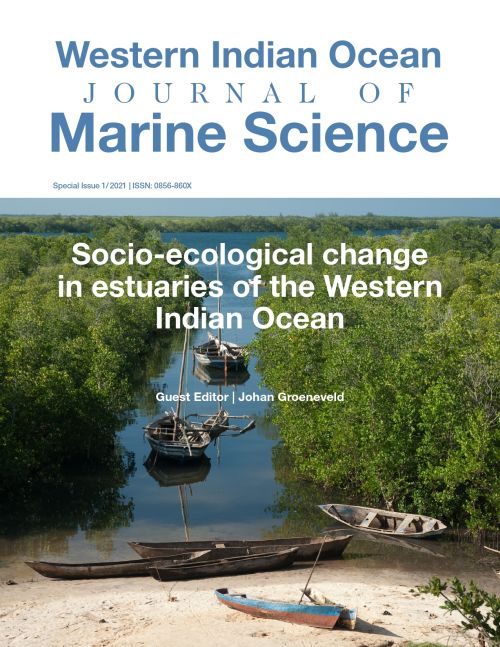Main Article Content
Small-scale fisheries of the Tana Estuary in Kenya
Abstract
The role of small-scale fisheries in maintaining socio-ecological systems (SES) in the Western Indian Ocean is well-documented, yet few studies have addressed estuarine fisheries in the region. Small-scale fisheries in the Tana Estuary in Kenya are described in this paper, accounting for location along a salinity gradient, seasonality, gear types used, species composition and relative abundance of landings. Monthly shore-based sampling was undertaken at four locations in 2017 – Ungwana Bay near the estuary mouth, lower and mid-estuary, and upper estuary at Ozi village, ⁓10 km upstream. Fishing gear comprised of seine nets, gillnets, hook-and-line and traditional gear such as self-made traps, sticks and spears operated from the shore (foot fishers), dugout canoes, dhows and fibreglass boats with outboard engines. A total of 12,840 fish and crustacean specimens belonging to 89 species in 45 families were sampled. Landings were dominated by catfishes Arius africanus (31 %) and Clarias gariepinus (21 %), small pelagic fishes Pellona ditchela (10 %) and several sardine species (⁓5 %), croaker Otolithes ruber (10 %), eel catfish Plotosus limbatus (6 %), mullet Mugil cephalus (4 %) and Nile tilapia Oreochromis niloticus (4 %). Multivariate analyses (nMDS and ANOSIM) found that fishing gear (p < 0.05) and location (p = 0.001) significantly influenced catch composition, but season (p = 0.146) was not significant. Traps were used in the upper and mid estuary only and were selective for three catfish species. Seine nets (54 species) and gillnets (40 species) were least selective and used at all four locations. Rarefaction curves indicated that species diversity was higher at the bay and lower estuary than the mid and upper estuary, and that diversity was highest for canoe-gillnet and canoe-encircling net combinations. Catch rates (avg. of 2.3 to 8.4
kg.fisher-1.day-1) depended on gear type and was highest for monofilament gillnets. Catches comprised a broad size range of multiple species, but on average, seine nets selected smaller individuals than traps, gillnets and long lines. The high complexity and organization of the fishery at an estuary-scale makes it a good example of a relatively intact SES suitable for regional comparative analyses.




